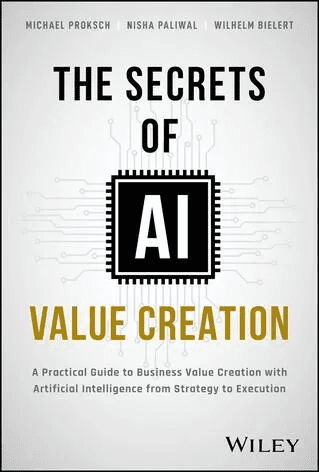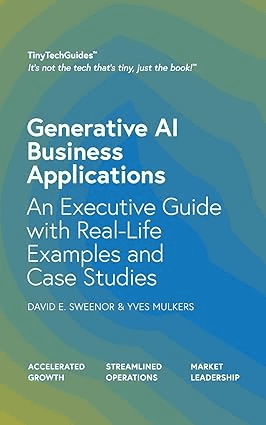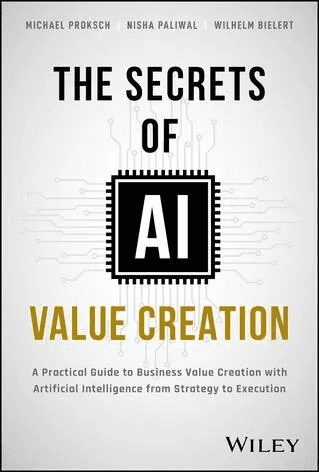The Secrets of AI Value Creation: A Practical Guide to Business Value Creation with Artificial Intelligence from Strategy to Execution

“Secrets of AI Value Creation” by Michael Proksch, Nisha Paliwal, Wilhelm Bielert is a timely and insightful exploration of how businesses can harness the transformative potential of AI to drive sustainable value. The authors, each bringing deep global experience in strategy, innovation, and digital transformation, combine academic rigor with real-world applications to deliver a practical roadmap for business leaders navigating the complexities of AI adoption. Link here.
The book is not another technical manual or speculative manifesto. Instead, it delivers a grounded and strategic lens through which executives can view AI—not just as a technology, but as a catalyst for business model innovation, operational efficiency, and long-term competitive advantage. With clear structure and well-illustrated examples, the authors avoid hype and focus on actionable insights, emphasizing strategic alignment, leadership mindset, and cross-functional integration as key enablers of AI value creation.
One of the book’s strengths lies in its emphasis on systems thinking. It goes beyond isolated use cases and delves into how AI reshapes entire value chains, stakeholder relationships, and ecosystems. For business leaders, this is particularly useful: it challenges them to think holistically rather than narrowly about AI implementation. Another significant advantage is the integration of cultural and organizational factors. Too often, AI initiatives fail due to resistance or lack of alignment, and the authors tackle this head-on with frameworks that help leaders manage change effectively.
Perhaps most compelling is the book’s global perspective. Drawing from Asian, European, and American contexts, it provides a culturally nuanced understanding of AI adoption. This is a rare and valuable aspect for leaders operating in or expanding to international markets. In a world where AI is evolving rapidly, this book does not promise shortcuts—it equips decision-makers with the clarity, mindset, and tools to lead strategically and responsibly.
Practical, Experience-Based Guidance: The authors draw from real-world implementations rather than theoretical ideals. For business leaders who have faced the challenges of moving AI from concept to production, their insights about overcoming stakeholder resistance and managing the limitations of AI’s decision-making are invaluable.
Comprehensive Approach to AI Value: The book goes beyond technical considerations to address the full spectrum of factors that determine AI success. The distinction between four types of AI value creation provides business leaders with a vocabulary to articulate the strategic intent behind different AI initiatives which helps secure buy-in from board members and C-suite executives lacking technical backgrounds.
Focus on Organizational Readiness: The sections on enterprise integration and required capabilities offer concrete guidance for building AI-ready organizations. It emphasises cultivating an AI-friendly culture and practical advice for talent development.
Decision-Making Frameworks: Throughout the book, the authors provide structured approaches to common decision points in the AI journey. The data value framework, project development approach selection guide, and talent competency model are particularly useful tools that help transform abstract concepts into actionable steps.
For business leaders navigating the complexities of AI implementation, this book offers a valuable roadmap based on hard-won experiences. Whether you’re just beginning your AI journey or working to scale existing initiatives, “The Secrets of Value Creation with Artificial Intelligence” provides the strategic guidance and tactical advice needed to translate AI potential into tangible business value.
Generative AI Business Applications: An Executive Guide with Real-Life Examples and Case Studies

“Generative AI Business Applications: An Executive Guide with Real-Life Examples and Case Studies” by David E. Sweenor and Yves Mulkers is a timely and practical resource for business leaders seeking to understand and implement generative AI in their organizations. Both authors bring extensive experience in AI, data strategy, and analytics, offering a concise yet comprehensive guide that demystifies the application of generative AI across various industries and departments. Link here.
The book distinguishes itself by focusing on over 70 real-world case studies spanning 12 industries and 11 departments, providing concrete examples of how generative AI is currently being utilized in business contexts. This approach moves beyond theoretical discussions, offering readers actionable insights into the practical implementation of AI technologies. The authors address critical aspects such as AI risks, implementation considerations, operations, ethics, and the importance of trustworthy AI, ensuring a well-rounded perspective on the subject.
One of the book’s significant strengths is its accessibility; it avoids technical jargon, making complex AI concepts understandable for non-technical executives. This clarity empowers leaders to make informed decisions about AI adoption and integration within their organizations. Additionally, the book’s structure allows readers to quickly find relevant information pertinent to their specific industry or departmental needs, enhancing its utility as a reference guide.
Comprehensive Industry and Functional Coverage: The book’s extensive mapping of generative AI applications provides business leaders with concrete examples relevant to their specific contexts. This breadth of coverage helps executives identify opportunities that might otherwise be overlooked and understand how peer organizations are leveraging generative AI. Leaders can benchmark their organization’s AI readiness against industry standards and identify high-potential use cases specific to their sector.
Balanced Technical and Business Perspective: The authors skilfully present technical concepts in business-friendly language without oversimplification. The explanation of model types and implementation components provides sufficient technical depth for informed decision-making while remaining accessible to non-technical executives. This balanced approach empowers business leaders to have more productive conversations with technical teams and make more informed decisions about AI investments.
Strong Governance Framework: The extensive treatment of governance, risk, and compliance issues offers valuable guidance for responsible AI implementation. In an increasingly regulated environment, the authors’ thorough examination of ethical considerations, data privacy, regulatory concerns, and fairness provides business leaders with a framework for mitigating risks associated with generative AI deployment. This section helps organizations build trust with stakeholders and avoid potential reputational or legal issues.
Actionable Implementation Guidance: The book excels in translating concepts into practical steps through its “Practical Advice and Next Steps” sections. The authors provide concrete guidance on building business cases, managing organizational change, and selecting appropriate technologies. This implementation focus helps bridge the gap between AI aspiration and execution, addressing common challenges that derail many AI initiatives.
For executives and business leaders seeking to understand and leverage generative AI technologies, this guide offers a thoughtful balance of conceptual understanding and practical application. Its industry-specific insights and functional perspectives make it relevant to a wide range of organizations, while its focus on governance and implementation guidance addresses the most common challenges in AI adoption.




